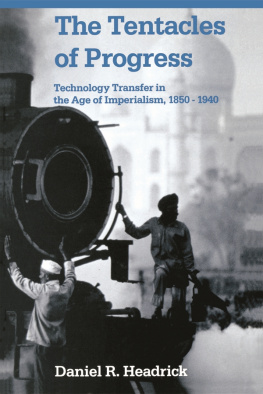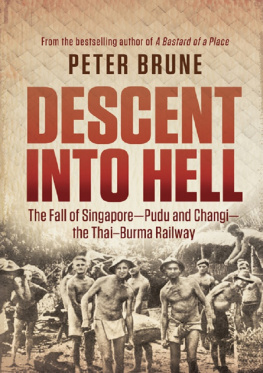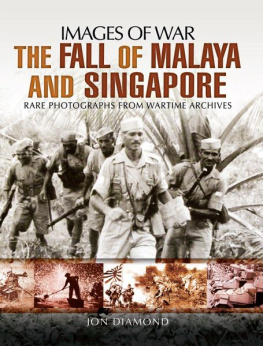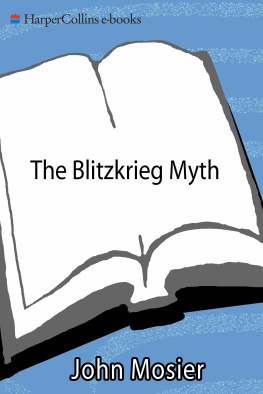
This edition is published by PICKLE PARTNERS PUBLISHINGwww.picklepartnerspublishing.com
To join our mailing list for new titles or for issues with our books picklepublishing@gmail.com
Or on Facebook
Text originally published in 1994 under the same title.
Pickle Partners Publishing 2014, all rights reserved. No part of this publication may be reproduced, stored in a retrieval system or transmitted by any means, electrical, mechanical or otherwise without the written permission of the copyright holder.
Publishers Note
Although in most cases we have retained the Authors original spelling and grammar to authentically reproduce the work of the Author and the original intent of such material, some additional notes and clarifications have been added for the modern readers benefit.
We have also made every effort to include all maps and illustrations of the original edition the limitations of formatting do not allow of including larger maps, we will upload as many of these maps as possible.
Bicycle Blitzkrieg: The Malayan Campaign and the Fall of Singapore
by
LCDR Alan C. Headrick USNR
TABLE OF CONTENTS
Contents
TABLE OF CONTENTS
REQUEST FROM THE PUBLISHER
ABSTRACT
Japan's December 1941-February 1942 invasion of Malaya and culminating conquest of Singapore is analyzed from an operational perspective. Although overshadowed by better known Pacific Theater actions in World War II, the campaign was Japan's most successful example of joint warfare and replete with lessons for the modern operational commander. Approached from the level of the commander and staff, the background and decision making processes are reviewed, with applicable areas identified for today's leaders. The need for aggressive leadership, accurate intelligence, flexible application of power, adjustment of force based on environmental conditions, and the value of logistics are the major lessons from the Japanese victory. Poor leadership and futility of trying to defend too much are among those lessons from the defeated British.
Bicycle Blitzkrieg: The Malayan Campaign and the Fall of Singapore
CHAPTER I INTRODUCTION
Thesis:
Through effective application of the principles of joint warfare, and mastery of the operational art, the Japanese achieved a brilliant victory over the British by their conquest of Malaya and Singapore. Japanese actions in the Malaya campaign were highlighted by powerful leadership, coordination, and innovative planning, training, and execution which provide superb lessons worthy of study by operational commanders.
Introduction:
The Imperial Japanese Army's Lieutenant General Tomoyuki Yamashita and his 25th Army, outnumbered in some accounts by as much as three to one, opened World War III with an unparalleled accomplishment of arms: conquest of the entire 700-mile Malay Peninsula in 70 days. In the process, Japan's joint forces inflicted a psychologically devastating defeat on the British when they sank the only Royal Navy capital ships in the Pacific; destroyed the allied British, Australian, Indian, and Malayan defenders (while tearing through the "impassable" Malay jungle); and overpowered the "impregnably" Fortress Singapore. This victory would ultimately mark the end of the British Empire in Asia, while the psychological impact of the defeat would stay with Britain throughout the entire war.
The Malaya Campaign, culminated by the fall of Singapore, has been overshadowed by better known Pacific campaigns, such as Pearl Harbor and the invasion of the Philippines. Nevertheless, the operations in Malaya are worthy of study. The Japanese forces demonstrated proficiency in proper and timely utilization of the tenets of the operational art. This campaign clearly shows the worth of strong command, control, and coordination. It highlights the value of accurate intelligence and unity of purpose. And finally, it points out problems and challenges of warfare that are applicable in the post-Cold War world.
The successful execution of the Malaya Campaign relied upon tactical proficiency and support by each of the armed services. The invasion involved naval convoy support, amphibious landings, naval air cover and bombardment, ground force air support, and ground operations. The jointly planned objectives were well defined and, as a result, tactical commanders were able to support operational requirements without the need for constant guidance. The rapid defeat of the defending force was due in large part to cooperation and coordination between the services.
Of the numerous reasons for the campaign's success, four primary factors stand out above the rest. First, Japan recognized the need for, and obtained, accurate and timely intelligence concerning the defenders and the battlefield. Second, Japan was able to exploit the fortress mentality of the British and residents of Singapore, who mistakenly placed their confidence in the illusion of the city's invincibility. Third, planning and preparation by the Japanese proved far superior to that of the Allied defenders. Finally, the ingenuity and flexibility displayed by Japanese commanders and staff personnel resulted in force multiplication through successful deceptions, and ultimately, rapid victory.
CHAPTER II STRATEGIC AND OPERATIONAL PLANNING
Although avoidance of war with the west had been a major tenet of Japanese foreign policy throughout 1939 and 1940, the possibility of conflict seemed more likely as time passed. By 1941, Japan decided to use force against the United States and Britain to circumvent American economic sanctions levelled against her. Japanese hopes rested upon their ability to seize control of the southern regions of Asia, the so-called Southern Resource Area. With conquest of this vital region, Japan reasoned it would be free of dependence on western powers for essential raw materials. If war came to the Pacific, the region would prove to be of great importance to Japan, who would control materials such as rubber, iron ore, aluminum, and the area's significant petroleum reserves. {1} Malaya, the location of vital materials, and Singapore, Britain's great naval base and symbol of her power in Asia, were keys to control of the Southern Resource Area. Conquest would also give Japan significant advantage in conduct of the war through control of the Malacca Strait, a major choke point between the Indian and Pacific Oceans. A final element in the decision to advance on Malaya and Singapore was the desire to "emancipate...oppressed peoples of Asia" from years of British rule. {2}
Intelligence collection for the invasion of Malaya started in January 1941 on the island of Formosa, where a small unit called The Taiwan Army Research Section was set up. Headed by Colonel Masanobu Tsuji, its purpose was to determine the requirements for successful tropical and jungle warfare. Over the next six months, the 10 man unit questioned area experts and specialists in all related fields and developed the necessary background for preparing troops to fight in the harsh jungle environment. Based upon his research, Tsuji reached three conclusions regarding the defenses in Malaya:
- Singapore Fortress was solid and strong facing the sea, but vulnerable on the peninsular side facing the Johore Strait;
- Newspaper reports of a strong Royal Air Force (RAF) presence were propaganda;










